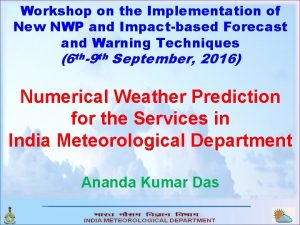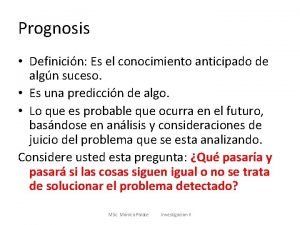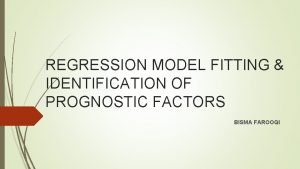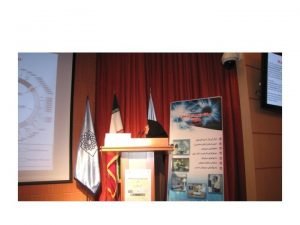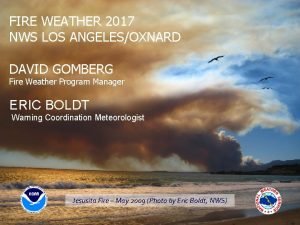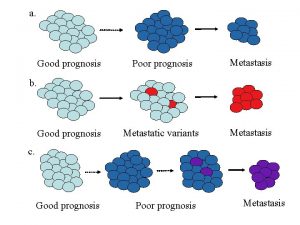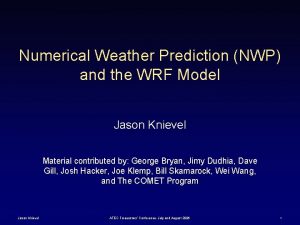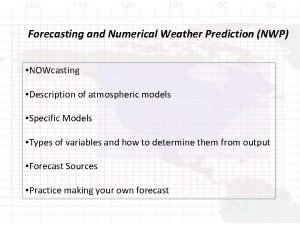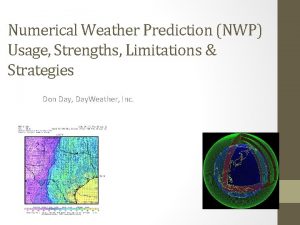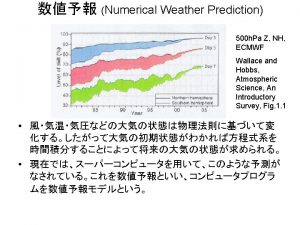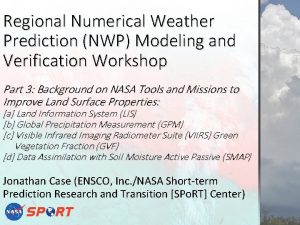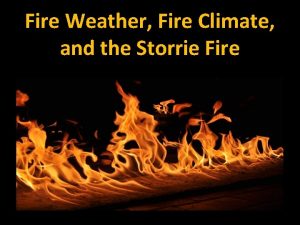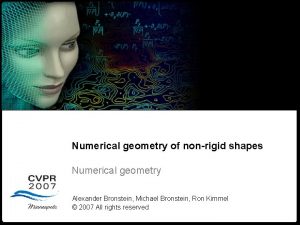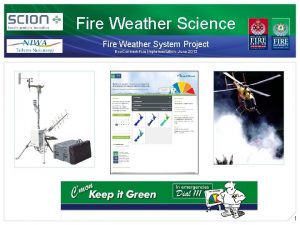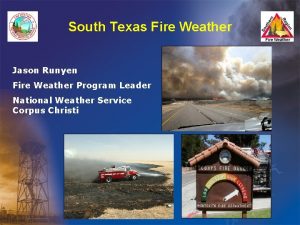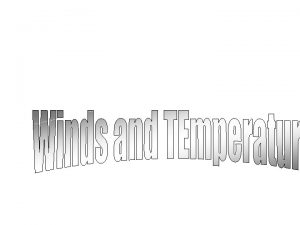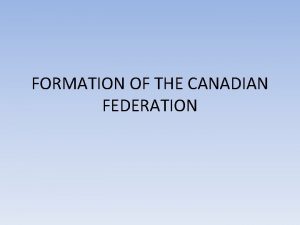Numerical Weather Prognosis NWP for Canadian Fire Weather

























- Slides: 25

Numerical Weather Prognosis (NWP) for Canadian Fire Weather Professionals (Kelowna, EC National Services Office, February 23 -27)

Monday, Tuesday NWP Basics and Model Components Contents n n n Coarse Overview NWP Basics (Terminology, model components, types, the 4 main models) GEM Model output (standard heights, 4 panels, XT, Tephis, Post Processing, Tons of Links) Links Your Own Forecasts and how they change over time. (Exercise)

Wednesday, Thursday Problems of the Components and : Contents n n n Components that fail (DA, initialization, precip/cloud paremterization) Differences due to model structure. Common problems (especially over mountains) Daily Model Discussions Typical Model behaviour case studies

Friday Post Processing: Contents n n n Statistical Post Processing More Model Specific Case Studies Buffer day (discuss, final questions, Q&A)

Why Weather Models? One purpose of NWP is to create the same maps we have analyzed so far (e. g. a 700 h. Pa chart with contours and moisture), that apply to a time in the future. This way we can apply all the traditional tools to see what the weather will be in the future.

… like this surface chart

How does this work? 1) Analyze the current weather (all levels all at the same time!) 2) Initialize the computer (grid or spectrum) with the analysis so that it can read it and do its calculations. 3) Run the computer and the software 4) Wait … 5) Wait some more. . . 5) When the computer is done: Tell it how to print/output the results (e. g. Print a 700 h. Pa map with moisture and wind barbs valid in 48 hours)

The Analysis n The drawing and interpretation of the patterns of various weather elements on a surface or upper-air chart. An analysis is typically done 4 times a day by national weather offices at 00 Z, 06 Z, 12 Z and 18 Z. n Surface / Upper Analysis Objective / Subjective Analysis BUT: Initialization! n A Subjective Surface Analysis n nhttp: //www. weatheroffice. gc. ca/analysis/index_e. html

Initialization (Transfering our analysis into the computer)

Horizontal Domains: Grid Points Time Step 5 knots 5ºC 5 knots 3ºC 4ºC 1ºC 2ºC Note: The locations between grid-points have no value assigned. For this reason, Grid Points represent the average over the whole grip box.

Horizontal Domains: Spectral 5 knots Time Step 5ºC Temp 4ºC 1ºC 3ºC 1ºC Temp = A(t, 3 D) * sin(longitude*F(t, 3 D)-offset(t, 3 D) West Note: Since there are no grid points, the spectral equation defines a value for every possible location. East

Horizontal Grids

Vertical Grids Small PGF errors n n n Sigma – Pressure Hybrid Isentropic-Sigma Hybrid Eta (old) Large PGF errors

Weather Models (Calculating on a 3 D grid)

Weather Models Grids Mesoscale 2. 5 km Topography Fraser Canyon Vancouver Island Vancouver Mt. Baker Victoria Olympic Mountains Mt. Rainier

Weather Models Grids Regional 15 km Topography Fraser Canyon Vancouver Island Vancouver Mt. Baker Victoria Olympic Mountains Mt. Rainier

Weather Models Grids Global Topography Fraser Canyon Vancouver Island Vancouver Mt. Baker Victoria Olympic Mountains Mt. Rainier

Parameterization Most “physical” fields/effects in the PBL have to be parameterized: • Mesoscale or smaller Convection • Soil Moisture/Evaporation • Friction effects • Land/Sea boundaries • Radiation absorption • Snow melt etc.

Precipitation: Coarse Model Grid n 15 km resolution 15 km 5 mm rain 15 km n The current (non mesoscale) regional model calculates all variables at locations that are 15 km apart. That means: If the model predicts 5 mm of rain over a location, it really means ‘an average of 5 mm over an area which is 15 km by 15 km (225 km 2) big’.

Precipitation: Small Model Grid 2. 5 km resolution n 2. 5 km 1 mm 1 1 1 1 major convective event 1 1 1 1 145 mm 1 1 1 15 km 1 1 2. 5 km n If we had a model with Still a 2. 5 km resolution 5 mm (LAM? ) we could make average the same prediction over these 225 km 2 …. But it is now accurate to 6. 25 km 2. And thus adds important information. 1 1 1 just ‘a few drops’

The Primitive Equations

Computer Output: The 4 Panel Chart (The same charts we always worked with except: for the future) a P 0 h Surface 700 h. Pa p i ec 50 r P

Other NWP output n n Thephigrams XT diagrams Meteograms Statistical Post Processing (MOS, UMOS, PP)

Regional and Global Models Since weather systems in the mid-latitudes move from west to east at a certain speed, a frontal band that will give central Canada a headache in ten days may, at this point, be only a tiny cumulus over central Russia. To properly forecast this feature you need a model that covers both, Russia and Canada. Thus, the further you want to forecast into the future, the larger your model domain has to be. At the same time, to include all features and observations between Canada and Russia the computers will be stretched to their limits and we have to make concessions: The most common concession: Decrease the model resolution and ’neglect’ small weather details. Global Models make long range forecasts. Regional/Mesoscale models make short/medium range forecasts.

The Big 4 North American Models Global Regional US Canada (NCEP) (CMC) GFS GEM Global (Global Forecast System) Previously MRF, then AVN WRF NAM (North American Mesoscale) (Global Environmental Multiscale) GEM Regional Honourable Mention: ECMWF Honourable Mention: RUC
 Nwp imd
Nwp imd Canadian fire alarm association
Canadian fire alarm association Autism prognosis
Autism prognosis R
R Global developmental delay symptoms
Global developmental delay symptoms Conocimiento anticipado de algún suceso
Conocimiento anticipado de algún suceso Cholangitis prognosis
Cholangitis prognosis Child-pugh score prognosis
Child-pugh score prognosis Autism prognosis
Autism prognosis Good prognosis
Good prognosis Prognosis vs diagnosis
Prognosis vs diagnosis Ich score prognosis
Ich score prognosis Good prognosis
Good prognosis Autism prognosis
Autism prognosis What is prognosis
What is prognosis Hellp syndrome labs
Hellp syndrome labs Prognosis of cystic fibrosis
Prognosis of cystic fibrosis Kanner's syndrome
Kanner's syndrome Orleans hanna algebra prognosis test
Orleans hanna algebra prognosis test Prognosis
Prognosis Uttar pradesh fire prevention & fire safety rules, 2005
Uttar pradesh fire prevention & fire safety rules, 2005 Rwi are
Rwi are Reichstag fire who was the fire starter
Reichstag fire who was the fire starter Fight fire with fire definition
Fight fire with fire definition Canvas connection hvac
Canvas connection hvac Fire weather snooper
Fire weather snooper
